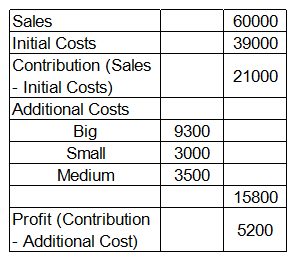1. A mixture comprises water and liquids A and B. The volume of water is 1/3rd of the total mixture and the volume of liquids A and B are in the ratio 5:3. To remove the water, the mixture is passed through a porous medium which completely absorbs the water and partially absorbs liquid A. Altogether this porous medium absorbs 200 ml of the initial mixture. If the ratio of volume of liquids A and B in the residual concentrated mixture becomes 7:9 then find the volume of water absorbed by the porous medium.
Show Similar Question And Answers
 Each of the Big, Small and Medium cost is categorized by the manager into Red, Yellow, Green and Violet costs. Breakdown of the additional costs under these headings is shown in the table below:
Each of the Big, Small and Medium cost is categorized by the manager into Red, Yellow, Green and Violet costs. Breakdown of the additional costs under these headings is shown in the table below: Red, Yellow, Green and Violet costs are allocated to different retail formats. These costs are apportioned in the ratio of number of units consumed by each retail format. The number of units consumed by each retail format is given in the table below:
Red, Yellow, Green and Violet costs are allocated to different retail formats. These costs are apportioned in the ratio of number of units consumed by each retail format. The number of units consumed by each retail format is given in the table below: Read the following statements:
Statement I. Online store accounted for 50% of the sales at BnC and the ratio of supermarket sales and book store sales is 1:2.
Statement II. Initial Cost is allocated in the ratio of sales. If you want to calculate the profit/loss from the different retail formats, then....
Read the following statements:
Statement I. Online store accounted for 50% of the sales at BnC and the ratio of supermarket sales and book store sales is 1:2.
Statement II. Initial Cost is allocated in the ratio of sales. If you want to calculate the profit/loss from the different retail formats, then.... Powered By:Omega Web Solutions
Powered By:Omega Web Solutions
Let us assume the volume of the total mixture to be 24x.
Volume of liquid A = 10x
Volume of liquid B = 6x
Volume of water = 8x
The mixture is passed through some medium that absorbs water completely and some quantity of liquid A.
Water absorbed = 8x
Let the amount of liquid A absorbed be y.
8x+y = 200
=> y = 200-8x -----(1)
It has been given that (10x-y)/8x = 7/9
Substituting (1), we get,
(10x-200+8x)/6x = 7/9
(18x-200)/6x = 7/9
162x-1800=42x
120x = 1800
=> x = 1800/120
Amount of water absorbed = 8*1800/120 = 120 ml.
Therefore, option E is the right answer.